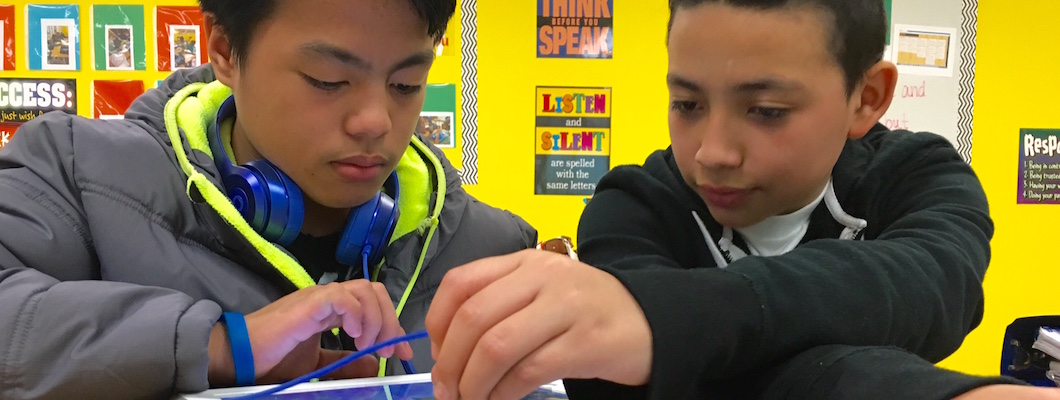
September 15, 2016 | By Haleh Yazdi
Research shows there are four elements that help students become naturally motivated to learn: challenge, goals, feedback, and curiosity. To find out how learning products can incorporate these elements, we spoke with Michelle Riconscente, president of Designs for Learning, Inc., a consulting company for product designers. Below we share her tips, along with other research-based ideas to help developers create products to improve student motivation.
Challenge
Students learn best when an activity is challenging, but attainable, and when they have a sense of control over their learning (1). If a task is too difficult, learners may feel frustrated and abandon the task (2). On the other hand, if an activity is too simple, students can quickly become bored and lose interest.
Learning products can provide an optimal level of challenge by giving students a range of difficulty levels and choices of tasks to complete. However, too many choices without enough structure can lead to ineffective learning or aimless engagement (3). Riconscente says one example of balancing free choice and difficulty level is when games have an exploratory nature to them, with embedded challenges.
Goals
Learning games that have compelling, obvious goals are significantly more popular among elementary school children than those that don’t. So, to keep students motivated, products can provide appropriate goals at each program level, as students progress (4). Additionally, learners stay motivated when they can see whether they are getting closer to a goal, so product designers may want to build in features that provide feedback and allow students to view their progress (5).
Game designers have also found that goals that integrate fantasy with learning (e.g., discovering a treasure chest using spatial skills) are more attractive to learners than those that require them to demonstrate skills in order to get back to the fun (e.g., solving math problems to unlock a door) (4, 6). An element of fantasy immerses learners, and sustains their attention.
Feedback
Students learn best when they receive ongoing feedback, especially when they can see personal improvement. Further, learners persist longer at playing games when they get immediate performance feedback (e.g., if their answer was right/wrong) combined with constructive feedback (e.g., what skills need improvement) (4).
Riconscente recommends products provide positive, informative feedback that enables the learner to deepen their understanding. “Instead of saying, ‘That’s wrong! Try again!’ more effective feedback would be, ‘Interesting answer! Let’s see what would happen if ,’” she said. Another strategy is to give learners examples or hints based on their incorrect answers. This works particularly well to maintain students’ motivation because it brings the challenge level into better alignment with their current grasp of the content.
Finally, the use of scoring is another way to provide feedback. Students view games with a scoring feature as more fun (4), and they also tend to persist longer, even when they do not receive high scores. The combination of a score and constructive feedback can help students stay motivated to keep learning.
Curiosity
A fourth way to motivate students is to spark their curiosity. For example, learners become engaged when they have just enough information to know what might happen, but the final outcome remains uncertain (4,6).
Products that incorporate an element of randomness or mystery, or that require students to uncover hidden information, can also pique their curiosity. Examples include asking students to solve problems with a set of clues, or to take on fantasy roles in narrative stories or simulation environments (4).
However, Riconscente advises against overusing these components. “If a student has to spend 20 minutes following a narrative before they’re doing something compelling, this detracts from interest,” she said. She advises product designers to be clear about the tool’s purpose (e.g., fantasy, mystery, avatars), and to use these tools strategically to enhance the user’s overall experience.
Learning products as interactive tools
Future research will help clarify the role of technology in boosting student motivation. We still have a lot to learn about which products work best for which students, and how to optimize the use of challenge, goals, feedback and curiosity in ed tech products to improve both learning and motivation outcomes.
Riconscente encourages developers to incorporate these research-based elements into their products, and to keep in mind a simple, overarching goal: to build products that help learners connect with our fascinating world in a new way. She adds, “When students feel that products give them the opportunity to grasp something new and fascinating about the world around them, this in itself can be motivating.”
To read more on Student Motivation, visit the Research Map.
References
1. Deci, E. L., & Ryan, R. M. (2000). The” what” and” why” of goal pursuits: Human needs and the self-determination of behavior. Psychological Inquiry,11(4), 227–268.
2. Boggiano, A. K. (1998). Maladaptive achievement patterns:A test of a diathesis-stress analysis of helplessness. Journal of Personality and Social Psychology, 74, 1681–1695.
3. Katz, I., & Assor, A. (2007). When choice motivates and when it does not.Educational Psychology Review, 19(4), 429–442.
4. Malone, T. W. (1981). What makes things fun to learn? A study of intrinsically motivating computer games. Pipeline, 6(2), 50.
5. Fisher, M. D., Blackwell, L. R., Garcia, A. B., & Greene, J. C. Effects of student control and choice on engagement in a CAl arithmetic task in a low-income school. Journal of Educational Psychology, 1975, 67, 776–783.
6. Habgood, M. J., & Ainsworth, S. E. (2011). Motivating children to learn effectively: Exploring the value of intrinsic integration in educational games.The Journal of the Learning Sciences, 20(2), 169-206.
By Lauren McMahon and Heather Dowd